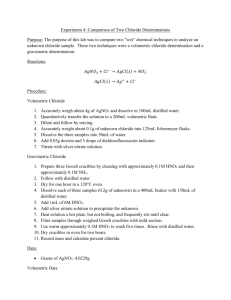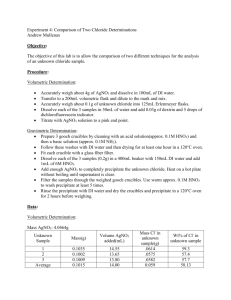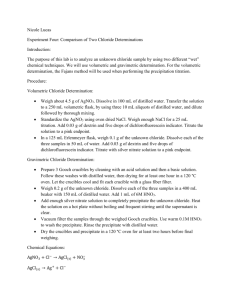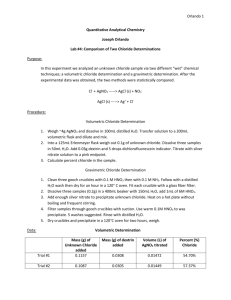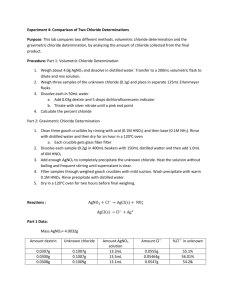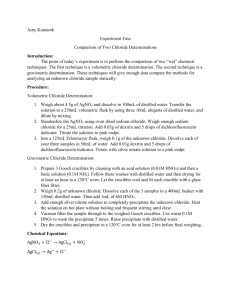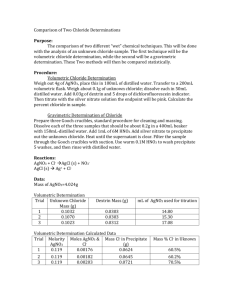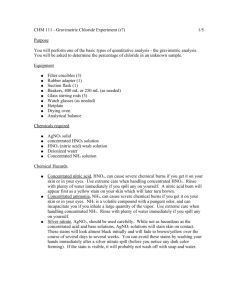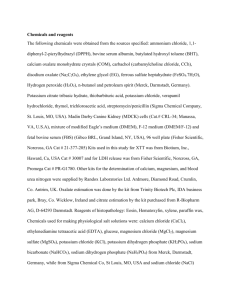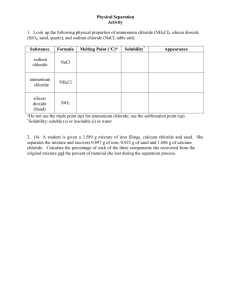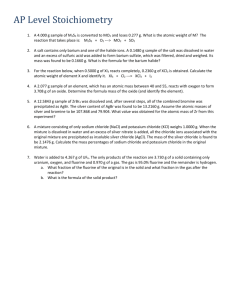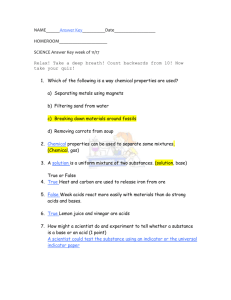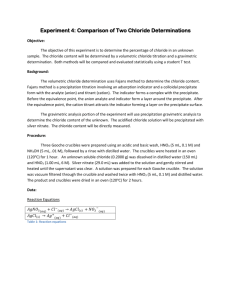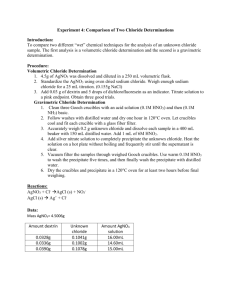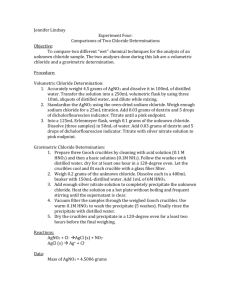Lab 4: Comparison of Chloride Determinations
advertisement
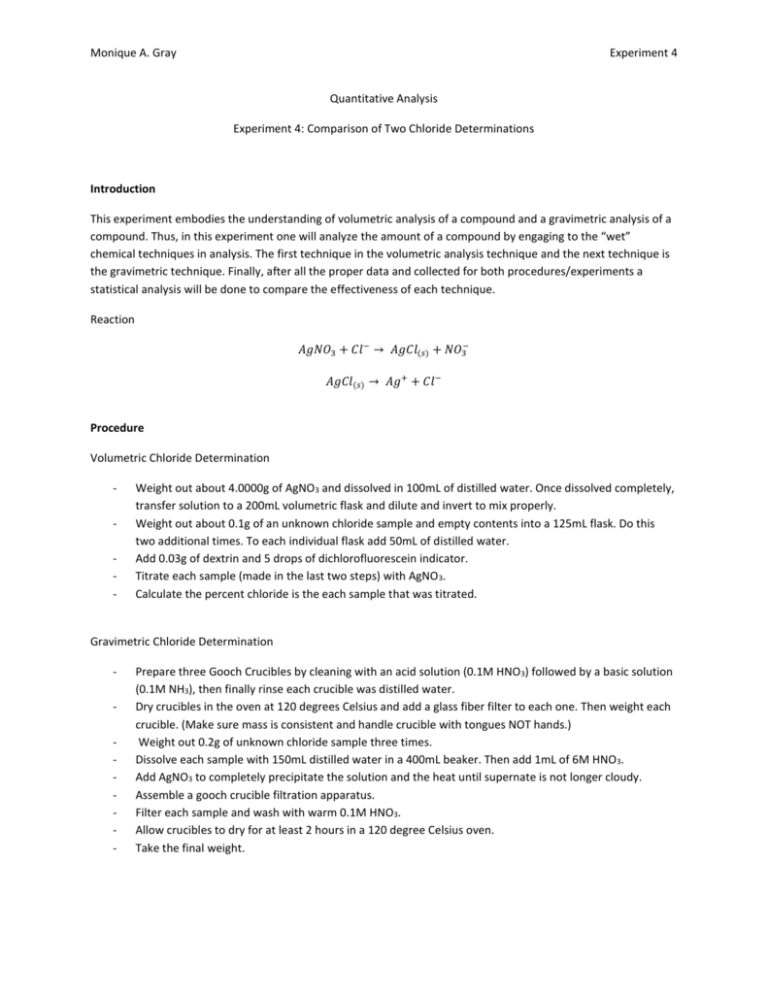
Monique A. Gray Experiment 4 Quantitative Analysis Experiment 4: Comparison of Two Chloride Determinations Introduction This experiment embodies the understanding of volumetric analysis of a compound and a gravimetric analysis of a compound. Thus, in this experiment one will analyze the amount of a compound by engaging to the “wet” chemical techniques in analysis. The first technique in the volumetric analysis technique and the next technique is the gravimetric technique. Finally, after all the proper data and collected for both procedures/experiments a statistical analysis will be done to compare the effectiveness of each technique. Reaction 𝐴𝑔𝑁𝑂3 + 𝐶𝑙 − → 𝐴𝑔𝐶𝑙(𝑠) + 𝑁𝑂3− 𝐴𝑔𝐶𝑙(𝑠) → 𝐴𝑔+ + 𝐶𝑙 − Procedure Volumetric Chloride Determination - Weight out about 4.0000g of AgNO3 and dissolved in 100mL of distilled water. Once dissolved completely, transfer solution to a 200mL volumetric flask and dilute and invert to mix properly. Weight out about 0.1g of an unknown chloride sample and empty contents into a 125mL flask. Do this two additional times. To each individual flask add 50mL of distilled water. Add 0.03g of dextrin and 5 drops of dichlorofluorescein indicator. Titrate each sample (made in the last two steps) with AgNO 3. Calculate the percent chloride is the each sample that was titrated. Gravimetric Chloride Determination - Prepare three Gooch Crucibles by cleaning with an acid solution (0.1M HNO 3) followed by a basic solution (0.1M NH3), then finally rinse each crucible was distilled water. Dry crucibles in the oven at 120 degrees Celsius and add a glass fiber filter to each one. Then weight each crucible. (Make sure mass is consistent and handle crucible with tongues NOT hands.) Weight out 0.2g of unknown chloride sample three times. Dissolve each sample with 150mL distilled water in a 400mL beaker. Then add 1mL of 6M HNO3. Add AgNO3 to completely precipitate the solution and the heat until supernate is not longer cloudy. Assemble a gooch crucible filtration apparatus. Filter each sample and wash with warm 0.1M HNO3. Allow crucibles to dry for at least 2 hours in a 120 degree Celsius oven. Take the final weight. Monique A. Gray Experiment 4 Data/Calculations Volumetric Determination Mass of AgNO3 = 4.005g Volumetric Titration Mass of Unknown 0.1014g 0.1017g 0.1009g Unknown Sample # 1 2 3 mL AgNO3 titrated 13.80mL 13.86mL 14.90mL Calculate the grams of Chloride Ion in Sample: (using sample one data) 13.80𝑚𝐿 𝑜𝑓 𝐴𝑔𝑁𝑂3 4.0058𝑔 1 𝑚𝑜𝑙 𝐴𝑔𝑁𝑂3 1 𝑚𝑜𝑙 𝐶𝑙 − 35.435𝑔 𝐶𝑙 − = 0.0576𝑔𝐶𝑙 − 1 200𝑚𝐿 169.86𝑔𝐴𝑔𝑁𝑂3 1𝑚𝑜𝑙 𝐴𝑔𝑁𝑂3 1 𝑚𝑜𝑙 𝐶𝑙 − Percent Chloride Ion in Sample (using sample one data) 0.0576𝑔 𝐶𝑙 − = 0.5680 𝑥 100 = 56.8% 0.1014 𝑔 Gravimetric Determination Mass of Unknown of Chloride Sample 1. 2. 3. 0.2043g unknown 0.2016g unknown 0.2085g unknown Mass of Gooch Crucibles After 1hr of Drying (with glass fiber) 1. 2. 3. 23.2381g 22.5110g 22.6843g Mass After 2hrs of Drying (with glass fiber) 1. 2. 3. 23.7116g 22.9827g 23.1722g Mass of Chloride Product (after 2hr drying) 1. 2. 3. 0.4700g 0.4719g 0.4680g Monique A. Gray Experiment 4 Amount of Silver Nitrate Needed to Precipitate the Cl- ion 0.2016𝑔 𝐴𝑔𝑁𝑂3 0.5851 1 𝑚𝑜𝑙 𝐶𝑙 − 1 𝑚𝑜𝑙 𝐴𝑔𝑁𝐴𝑔𝑁𝑂𝑂3 169.86𝑔 200𝑚𝐿 = 28.23𝑚𝐿 1 1 35.435𝑔 1 𝐶𝑙 − 1 𝑚𝑜𝑙 𝐴𝑔𝑁𝑂3 4.0058𝑔 𝐴𝑔𝑁𝑂3 Mass of Chloride in sample 0.4719 1 𝑚𝑜𝑙 𝐴𝑔𝐶𝑙 1 𝑚𝑜𝑙 𝐶𝑙 − 35.453𝑔 = 0.1167𝑔 𝐶𝑙 − 1 143.32𝑔 1 𝑚𝑜𝑙 𝐴𝑔𝐶𝑙 1 𝑚𝑜𝑙 𝐶𝑙 − Percent Chloride in Sample 0.1167𝑔 𝐶𝑙 − = 0.5789 𝑥 100 = 57.89% 0.2016𝑔 Volumetric Percent Chloride 1. 2. 3. 56.80% 56.93% 61.70% Gravimetric Percent Chloride 1. 2. 3. 56.93% 57.895 55.54% Difference 1. 2. 3. 0.13 1.02 6.16 Mean of difference: 2.4367 Standard Deviation: 10.59535 Tcalc; 0.2698 Calculation for Standard deviation: 𝑠= √∑(𝑑𝑖 − 𝑑)2 𝑛−1 Calculation for tcalc Tcalc = |𝑑| 𝑠 √𝑛 B. Given that t- table at a 95% confidence interval was 2.78, since t-calc was less than t-table then there is no significant difference between the two types of ‘wet’ chemical analysis. Thus, whether chloride is analysis using the volumetric or gravimetric technique, both techniques are proven to given similar answers. Monique A. Gray Experiment 4 C. The titration could be done in a manner in which droplet intervals could be done and this will lead to be better endpoint a more accurate endpoint. The same with measuring out the mass of a sample, trying to get it closer to a particular number or trying to get each sample’s mass within a certain range of each-other. This could produce more accurate and consistent results. For example, if told to measure out 4g try to get exactly 4g or try to get each measurement that was measured within possibly 0.003g within the previous measurement. Also, when measuring out particular volumes of liquid try to choose the most appropriate glassware to measure the liquid in. If doing so, this could significantly enhance results and possibly the yield of the reaction. Another change or tip would be to make sure all rounding and measuring is kept consistent. Math is a big part of mostly all experiments so checking the math and maybe recalculating someone isn’t such as bad idea. This could possible enhance your results. Developing a better technique to handle crucibles could drastically enhance results because weighting by difference was one of the big measurements in this experiment and if you’re handling crucibles wrong this could cause the mass to be a little off and in experiment where accuracy and precision matter, it’s a big error. Properly washing crucibles could also be improved. Maybe washing them an extra time wouldn’t hurt. When drying the crucibles an important factor is making sure that all measurement are reproducible or within 0.003g of the previous measurement. Sticking to this technique could greatly influence your overall yield especially when you have to weigh by difference. Finally when filtrating the sample, you could perform an extra wash to help purify the sample even more and to help lower the amount of impurities in the sample. A better transfer technique could also be incorporated into the experiment, such as, using the washing solution to gather the left over sample from the bear or flask when transferring the sample.
